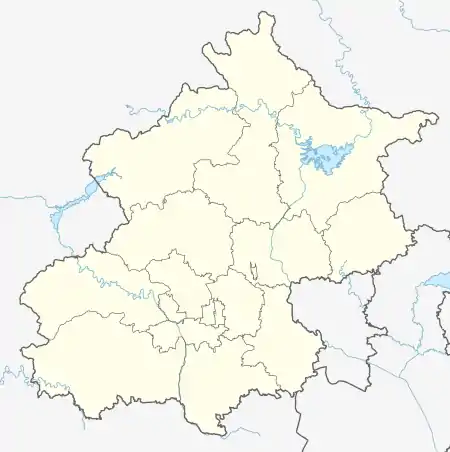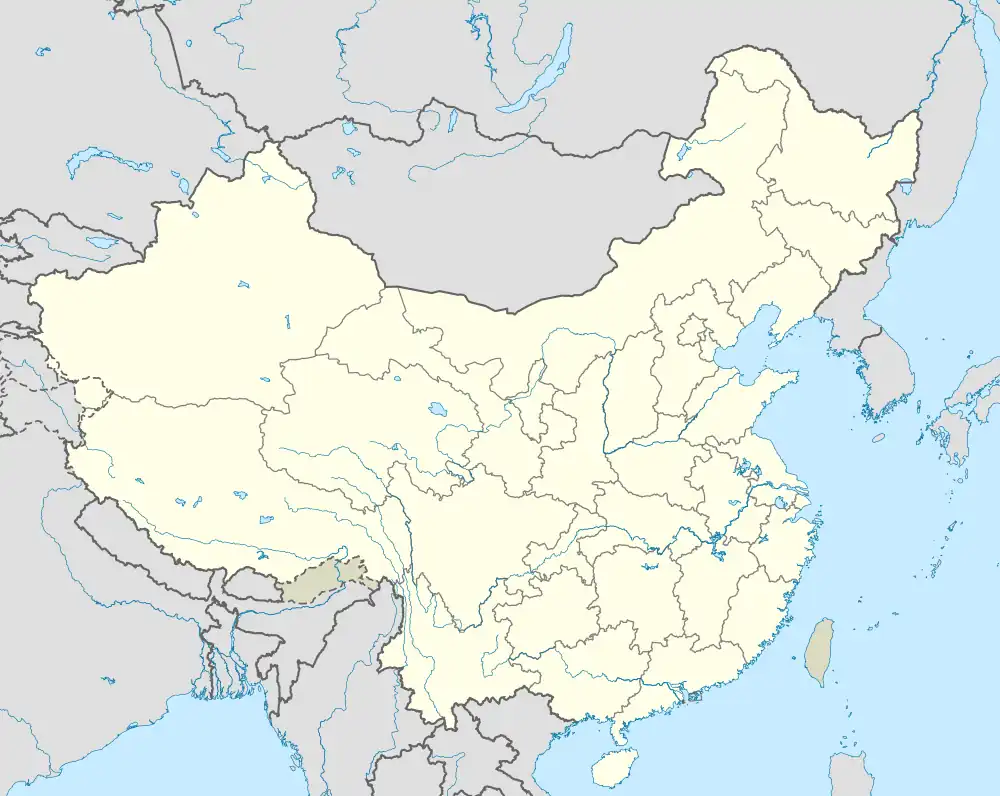Tanying Area
檀营地区 | |
|---|---|
.JPG.webp) Xinbei Road within the area, 2015 | |
.png.webp) Location of Tanning Area within Miyun District | |
 Tanying Area  Tanying Area | |
| Coordinates: 40°23′22″N 116°51′47″E / 40.38944°N 116.86306°E | |
| Country | China |
| Municipality | Beijing |
| District | Miyun |
| Village-level Divisions | 3 communities |
| Area | |
| • Total | 2.9 km2 (1.1 sq mi) |
| Elevation | 82 m (269 ft) |
| Population (2020) | |
| • Total | 15,466 |
| • Density | 5,300/km2 (14,000/sq mi) |
| Time zone | UTC+8 (China Standard) |
| Postal code | 101511 |
| Area code | 010 |
Tanying Area (simplified Chinese: 檀营地区; traditional Chinese: 檀營地區; pinyin: Tányíng Dìqū) is an area and an ethnic township located in the Miyun District of Beijing, China.[1] Located on the south of Ye Mountain (冶山), it shares border with Mujiayu Town in its north and east, Gulou Subdistrict in its southwest, and Miyun Town in its northwest. In 2020, the area had 15,466 inhabitants under its administration.[2]
The name Tanying (Chinese: 檀营; lit. 'Tan Barrack') originates in 1777, when the region, which was called Tan Department (檀州) at the time, was used as a garrison for stationing Eight Banners troops.[3]
History
| Year | Status | Under |
|---|---|---|
| 1953 - 1958 | Tanying Township | Miyun County, Hebei |
| 1958 - 1965 | Administered by Chengguan People's Commune | Miyun County, Beijing |
| 1965 - 1987 | Administered by Mujiayu People's Commune | |
| 1987 - 2005 | Tanying Manchu and Mongol Ethnic Township | |
| 2005 - 2015 | Tanying Area (Manchu and Mongol Ethnic Township) | |
| 2015 - present | Miyun District, Beijing |
Administrative divisions
In 2021, Tanying Area is formed from 3 residential communities, and they are organized in the following table:[4]
| Subdivision Names | Name Transliterations |
|---|---|
| 檀营 | Tanying |
| 第一 | Diyi |
| 第二 | Di'er |
Gallery
 Entrance of Miyunbei Railway Station on the west of the area, 2016
Entrance of Miyunbei Railway Station on the west of the area, 2016 Rail tracks within Miyunbei Railway Station, 2016
Rail tracks within Miyunbei Railway Station, 2016
See also
References
- ↑ "Tanying Area, Miyung, Beijing, China". www.aldpage.com. Retrieved 2018-04-11.
- ↑ "北京市密云区第七次全国人口普查公报". www.bjmy.gov.cn. Retrieved 2022-10-31.
- 1 2 Zhong hua ren min gong he guo zheng qu da dian. Bei jing shi juan. Li li guo, Li wan jun, Wu shi min, 李立国., 李万钧., 吴世民. Bei jing: Zhong guo she hui chu ban she. 2013. ISBN 978-7-5087-4058-4. OCLC 910451741.
{{cite book}}: CS1 maint: others (link) - ↑ "2021年统计用区划代码和城乡划分代码". www.stats.gov.cn. Retrieved 2022-10-29.
This article is issued from Wikipedia. The text is licensed under Creative Commons - Attribution - Sharealike. Additional terms may apply for the media files.